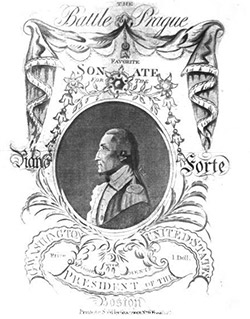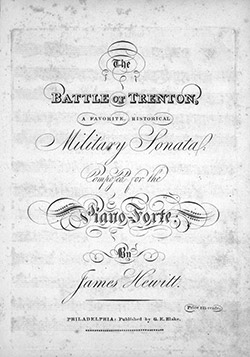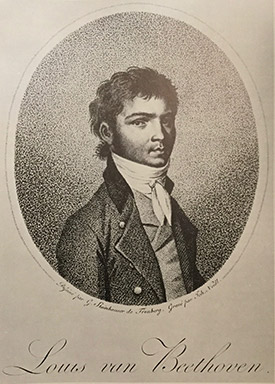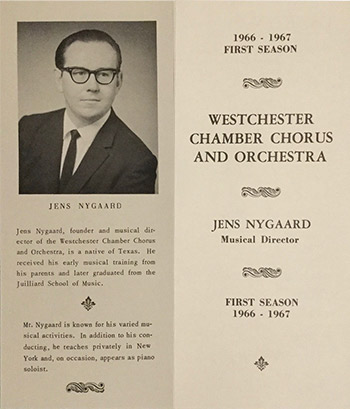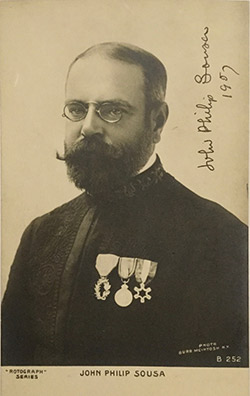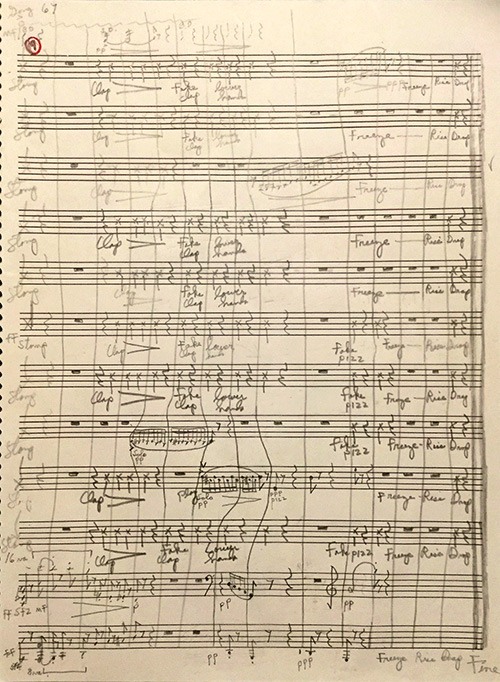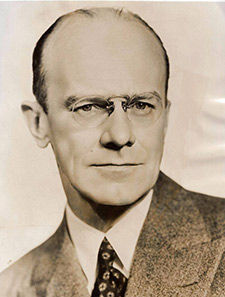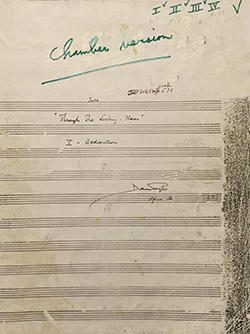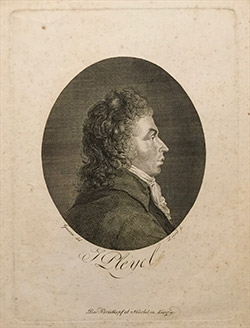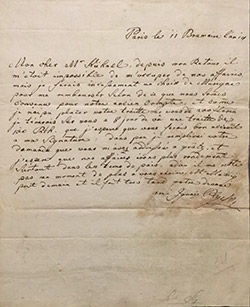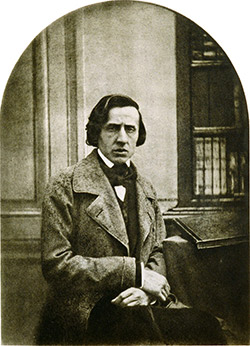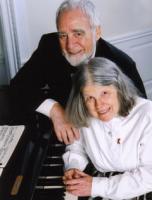
The concerts were canceled because of the coronavirus epidemic. Fortuitously, our Jupiter musicians had the good sense to record the rehearsal in an impromptu decision, literally minutes before pressing the record button on an iphone. Pianist Mackenzie Melemed (replacing Roman Rabinovich) learned the music in 2 days! Bravo to him.
John FIELD Divertissement No. 1 H. 13
~ simply delicious piano quintet, alternately titled Rondeau Pastoral and better known in its version for solo piano, Twelve O’clock Rondo, on account of the 12 “chimes” at the end ~ by the creator of the Nocturne, which had a major influence on Chopin
We thank the University of Illinois (Champaign) for a copy of the Divertissement music.
Mackenzie Melemed piano
Abigel Kralik violin
Dechopol Kowintaweewat violin
Sarah Sung viola
Christine Lamprea cello
Sir Hamilton HARTY Piano Quintet in F Major Op. 12
~ in a lyrical Romantic idiom, with a distinct, breezy Irish-salted voice
Andrew Clements of the Guardian proclaimed the beautiful Quintet “a real discovery: a big, bold statement full of striking melodic ideas and intriguing harmonic shifts, which adds Brahms and Dvořák into Harty’s stylistic mix, together with Tchaikovsky in some passages.” There’s folk music charm as well, reminiscent of Percy Grainger—notably in the Scherzo (Vivace) with its folksy quirks and nonchalance, and the winding, pentatonic melody in the Lento.
Our gratitude to the Queen’s University Library in Belfast, Northern Ireland, for a copy of the autograph manuscript of the music. Much thanks, too, to Connor Brown for speedily creating a printed score and parts from Harty’s manuscript.
Mackenzie Melemed piano
Abigel Kralik violin
Dechopol Kowintaweewat violin
Sarah Sun viola
Christine Lamprea cello
Allegro 0:00
II Vivace 10:43
III Lento 14:44
IV Allegro con brio 23:59
Jupiter featured on Our Net News
American program opener on March 18, with grateful thanks to Michael Shaffer of OurNetNews.com for recording the matinee concert, and making available the Horatio Parker Suite video for our viewing pleasure.
Horatio Parker Suite in A Major, Op. 35, composed in 1893
Prelude
Stephen Beus piano, Stefan Milenkovich violin, David Requiro cello
Horatio Parker Suite in A Major, Op. 35
Tempo di menuetto
Stephen Beus piano, Stefan Milenkovich violin, David Requiro cello
Horatio Parker Suite in A Major, Op. 35
Finale
Stephen Beus piano, Stefan Milenkovich violin, David Requiro cello
If you missed Maxim Lando at Jupiter...
Maxim Lando playing Chopin’s Fantasie Impromptu as an encore
Jupiter on YouTube
featured in a short documentary on artist Michael McNamaraNEW YORK CANVAS : The Art of Michael McNamara is a video portrait of the artist who has painted iconic images of New York City for more than a decade, capturing the changing urban landscape of his adopted city. Our Jupiter Symphony Chamber Players provide the music from Brahms’s Piano Quartet in G Minor, underscoring the inspiration the artist has drawn from Jens Nygaard and the musicians. Michael was also our Jupiter volunteer from 2002 to 2010.
Here is a video of the Jupiter Symphony Chamber Players performance of the Rondo alla Zingarese movement:
Alessio Bax piano
Dmitri Berlinsky violin
Dov Scheindlin viola
Wendy Warner cello
Lucille Chung page turnerProduced by Interaction Media
Directed by Martin Spinelli
Edited by Michael GrenadierTo view this excellent documentary in full, just click on: http://www.youtube.com/watch?v=xdmufpEtRmY
The producer-director, Martin Spinelli, also made the EMMY Award-winning “Life On Jupiter: The Story of Jens Nygaard, Musician.”
To view the artwork of Michael McNamara, visit www.mcnamarapaintings.com.

The EMMY Award-winning documentary is available on DVD with bonus music.
LIFE ON JUPITER: The Story of Jens Nygaard, Musician is a superb documentary that has won a New York Emmy and the highly respected Chris Award, as well as a nomination for “Outstanding Directorial Achievement” by the Directors Guild of America.
Awards won include:
- 2002 Emmy Award for Programming about the Arts
- Best Documentary Film Award at the 22nd Annual Breckenridge
Festival of Film.- Directors Guild of America’s Nomination for Outstanding
Achievement Award.- Hot Springs Documentary Film Festival Opening Night
- Chris Statuette Award at the Columbus International
Film & Video Festival.- Thunderbird International Film Festival Best Picture, Best Sound/Music, and Lisa Palattella, Editor, won the Karl Malden Award for excellence, ingenuity, and dedication to the project.
- Best Musical Film Award - Tiburon International Film Festival
- The BAC 36th International Film and Video Festival screening
at the Metropolitan Museum of Art, in Manhattan.- The International Film Festival of Fine Arts screening in Szolnok, Hungary
- Empire State Film Festival & Rhode Island International
Film Festival & Sedona International Film Festival screenings.Martin Spinelli began this project in January 2000 as a labor of love after attending a concert of the Jupiter Symphony. Juxtaposing a powerful biography with great music, the documentary has earned positive critical responses from publications as disparate as TV Guide and Video Librarian, while generating an enthusiastic following among music lovers and general audiences alike. Ruth Laredo, Joel Krosnick (Juilliard String Quartet), and William Wolfram are among the soloists that appear in this inspirational film. Life on Jupiter takes us on a musical and very personal journey, enhanced by selections from critically acclaimed performances.
This superb documentary on Jens Nygaard won the highly respected Chris Award capturing all seven rating points. Following its premiere broadcast on July 1, 2001 by WNET (Channel 13), it has been screened at film festivals, among them, Breckenridge (“Best Film of the Festival in Documentaries”), Thunderbird (4 awards, including Best Film and Best Music), Tiburon (named “Best Musical Film” it beat out Eroica, the film on the chamber group, The Eroica Trio), and Park City, Utah. It has also been screened at the Metropolitan Museum of Art, broadcast on public TV by WHYY in Philadelphia, and rebroadcast by WNET in July 2002 and by WNYE in July 2004. The documentary is now being shown on other public stations in the U.S. and internationally.
Produced by Martin Spinelli and edited by Lisa Palattella, Life on Jupiter was given top rating by Video Librarian: “An inspiring portrait of an inspired artist, Life on Jupiter is highly recommended.” If you wish to purchase your own copy to remember Jens by, or for more information and to view video clips visit www.lifeonjupiter.com.
We bring you something a little different this time—the historical military sonata, the most popular of the genre being František Kocžwara’s “The Battle of Prague” and James Hewitt’s “The Battle of Trenton.” These are 2 examples of programmatic music depicting battles on either side of the Atlantic. The recordings are from unedited live performances. We are also grateful to all of you who have donated your tickets and sent gifts in support of Jupiter’s musicians and music making. |
||||||||||
|
||||||||||
|
||||||||||
Most of us know this is Beethoven’s 250th year of his birth. Fifty years ago Jens Nygaard celebrated Beethoven’s 200th Birthday with a “Party” at Carnegie Recital Hall (today’s Weill Hall). The printed program for that concert on 16 December 1970 is missing from the Jupiter Archive, but it has been reconstructed from the review by Donal Henahan of the New York Times. We invite you to step back half a century and listen to several lesser known works by Beethoven that were performed that evening. Jens played the piano and clarinet. This is a live unedited recording. It has some sound quality issues, and you will also hear the musicians walking on and off the stage and some mic clunking as well. Regardless, you’re welcome to gatecrash the “Party” and get a taste Jens’s programming and piano playing. |
||||||||||
|
||||||||||
“Beethoven Concert Is Really a Party” It was not the grandest party thrown for Beethoven on his birthday, but it must have been one of the most intimate and charming. To every person’s program was attached a piece of Schmidt’s Viennese candy. As the audience of perhaps 125 people filed into Carnegie Recital Hall last night, friends greeted one another with smiles and several called out “Happy Birthday to you.” There was a kind of giddy euphoria in the air that sentimental occasions sometimes arouse. And why not? Jens Nygaard, a dear friend of Beethoven’s, and two dozen other friendly musicians were giving a party to which some of the composer’s forgotten children had been invited. There were, for instance, a miniature march in B flat for six winds, the Variations on a Swiss Air for Harp, two Preludes and Fugues for string quartet, the “Bundeslied” for women’s chorus and winds, the Adagio and Sonatina for Mandolin, assorted Allemandes, Allegros and Minuets for flutes, and Scottish folk songs—virtually nothing you ever heard, even in his Beethoven year. Mr. Nygaard, a violinist, conductor, pianist, and clarinetist, who looks somewhat like Gerard Hoffnung, the late English tuba virtuoso and cartoonist, explained to an intrigued visitor before the concert that his party had not been thrown together as a last-minute inspiration. “Two years ago I applied for this date at Carnegie Recital Hall, and got it. We have no financial backing, no built-in audience, no help of any sort.” Most of the music, he said, was not available from publishers, and he had to copy out much of it himself. “I did tremendous research in Vienna and elsewhere. I didn’t want to do just another sloppy ‘Eroica’—I’m not funded for that sort of thing anyway. I jobbed around, taught, borrowed money and almost sold the clothes off my back to raise the $1,500 or $1,600 that it cost to put this concert on. Most of the soloists, who are all high quality professionals, contributed their services, and my little Westchester Chamber Chorus came free. We just put ads in the paper and hoped.” If it happened to snow on concert night, the conductor added, he stood to lose a lot of money. (It did.) “But we all adore music, that’s all,” said Mr. Nygaard, who played both piano and clarinet during the concert. “I love it all—Beethoven, Schoenberg, Stephen Foster—any honest composer.” There was a “we-happy-few” tone in his voice as he named his fellow performers: Ruth Alsop, the cellist; Leonid Bolotine, the mandolinist; Diana Halprin, the violinist; Michael Best, the tenor; Gerardo Levy, the flutist. But why, Mr. Nygaard was asked, did he invest so much time, energy and money in his off-best little concert? “Why? Because I won’t be around for Beethoven’s 300th birthday. This was my chance to make a modest but, I hope, meaningful contribution.” And with a little help from his friends and Beethoven’s forgotten children, he did. |
||||||||||
Some of you may not know that the Jupiter Symphony was not Jens Nygaard’s first orchestra he founded. That distinction belongs to the Westchester Chamber Chorus and Orchestra. On 19 November 1966 Louisa Kreisberg of the Reporter Dispatch in White Plains announced the formation of “A No-Nonsense Chorus-Orchestra...to investigate discord and create harmony...under the direction of Jens Nygaard.... After weeks of rehearsal and preparation, the group’s members believe their voices will not go crying in the wilderness. ...Singing, according to Mr. Nygaard, is the most natural of all endeavors. ...We have housewives, a doctor, a lawyer, a nurse, and a principal of a posh private school.... There’s a very fine engineer who...has joined us because he wants to work, not to socialize.... Many people think that if they have a beautiful voice and can sing ‘Old Man River’ they can blend into a chorus. This isn’t so.... Our members have to read the right notes, the right rhythms, must blend, and have the right attitude toward to music. ...I expect them to have the love and dedication and ability to sight read so that the rehearsals can be concerned largely with the music content.... Our members want to learn more about music. They want to sing. They should become better musicians.... The Westchester Chamber Chorus and Orchestra has rolled up its sleeves, cleaned house, and gone to work....” How fortunate we are to have some music from the first 2 seasons. The recording of live performances, presumably selected by Jens, is from an LP record. Martin Bookspan, in an interview in 2002 for Life on Jupiter (the documentary on Jens), described his WCCO experience: “I went to one of the concerts and was bowled over. First of all by the musical intelligence that was manifest in that music making, secondly by the sheer exuberance and vitality of the music making. I went up to Jens after the concert and introduced myself and told him I had had a remarkable music experience. And happily we’ve been friends ever since.” Reviewers have echoed the sentiment. Muriel Brooks wrote in the Patent Trader, “No doubt about it, Jens Nygaard is turning the Westchester Chamber Chorus and Orchestra into a first rate musical organization.” Arnold Gamson of the Westchester Tattler added, “Rarely has an evening of listening been so satisfying. Here is a conductor in perfect rapport with his singers and players. Here is an ensemble totally dedicated to giving music the very best they are capable of and in this case it is a great deal.... Last night this music came alive in every detail revealing a splendor, a refinement of expression and a humanity that was breathtaking....” |
||||||||||
|
||||||||||
| As we value our priceless freedom, albeit presently shackled, but hopefully for not much longer, here’s more American music from the second half of an unedited, live performance on September 14, 1999 at Good Shepherd Church—7 classic marches by the American March King, John Philip Sousa—El Capitan,Thunderer, Semper Fidelis, King Cotton, High School Cadets, Washington Post, and Stars and Stripes Forever All the tunes are familiar, played à la Jens Nygaard—rhythmical and with upbeat tempos. Sousa held a special place in Jens’s heart as his father played in the Sousa Band. Enjoy. | ||||||||||
|
||||||||||
| The first half of the program comprised Jens Nygaard’s Foster Medley, which you’ll not hear anywhere else, and Deems Taylor’s most popular and now forgotten Through the Looking Glass. | ||||||||||
The Foster-Nygaard Medley is quintessential Jens. Based on songs by Stephen Foster, Jens weaves a tuneful ramble with imagination, interesting harmonies, seamless segues, and his own quirky and playful touches. A Treasury of Stephen Foster with a forward by Deems Taylor was the songbook that Jens read and annotated when choosing his selections for the Medley. The program’s pairing of Foster and Taylor was, incidentally, by chance, not design. The recording is from the first half of an unedited, live performance on September 14, 1999 at Good Shepherd Church. Before writing his Medley, Jens went to Pittsburgh, Pennsylvania in spite of pain in his leg to visit the Stephen Foster Memorial Museum and Foster’s grave in Allegheny Cemetery. Unbeknownst to anyone, including his doctor, Jens was already ill with multiple myeloma, but it was not diagnosed till his femur broke some months later in October 1999. Despite his discomfort he was charged with enthusiasm upon his return, and worked on the Medley right up through the dress rehearsal. |
||||||||||
Don’t miss the markings in the score as you listen to the music; and have some fun, too, identifying the songs. Can you name them all? There are 15 or 16, according to Jens’s opening remarks.
|
||||||||||
Deems Taylor’s Through the Looking Glass was composed in 1919, inspired by Lewis Carroll’s novel of the same title. Originally written for a chamber ensemble, Jens probably performed the “big version”—so marked on the title page of his score in green ink, and he drew the orchestra seating plan in red ink. However, he bowed the string parts for the “Chamber version” as well, and performed only 4 of the 5 “Pictures” as in the chamber score. The Suite is an imaginative and colorful adventure through Alice’s looking glass—a dreamy introduction to Alice, an immersion into the enchanted realm of the Jabberwock, a frolic with fantastical Insects, and a portrait of the White Knight. Never boring, Deems Taylor (1885-1966) was one of the best-known musical figures of the first half of the 20th century—a composer, music critic, author, commentator, artist, and broadcast personality. Among his numerous accomplishments, he was the voice of the New York Philharmonic; he composed The King’s Henchman, the first American opera commissioned by the Metropolitan Opera; and as the affable master of ceremonies for Disney’s animated Fantasia he won over moviegoers to classical music.
|
||||||||||
If you’d like to discover yet another facet to Deems Taylor, you may enjoy reading Moments Mousical with its impossible puns and splendid illustrations by Walter Kumme. Here, the great Micetro offers readers an education, beginning with ancient history in Mousopotamia, and in dance, opera, and mousic; and ending with violinist Fritz Miceler at Carnegie Hall and composer Gustav Mauser, who studied with Moussager, Moucheles, and Mouskowski. It‘s a trip. |
||||||||||
Although almost forgotten, Pleyel was all the rage in Europe in his heyday, won the admiration of Mozart, and there was even a Pleyel Society on the island of Nantucket. Not only did he compose prolifically, he was an important music publisher and piano maker as well. His firm provided pianos used by Chopin and his concert hall, Salle Pleyel, was where Chopin performed his first and his last Paris concerts. Chopin also owned a Pleyel Grand of 1839. Born in 1757 in Austria, Pleyel was the 24th of 38 children! (by one account). In 1772 he was sent to Eisenstadt to study with Haydn, and became his star pupil. By 1784 he was appointed assistant Kapellmeister at the Strasbourg Cathedral, succeeding as Kapellmeister in 1789 when Franz Xaver Richter died. In 1786 he also organized and conducted a series of concerts, which provided the opportunity to promote his compositions. When the French Revolution disrupted religious and cultural life in 1791, Pleyel moved to London, where his concerts and compositions were also highly praised. Upon his return to Paris in 1795, he opened a music shop and established the music publishing house, Maison Pleyel, that issued some 4000 works AND the first miniature scores! In 1807 he also founded a piano manufacturing company that, after a series of owners and mergers, was bought out by Schimmel of Brunswick in 1976. Pleyel died in 1831 after a truly illustrious career. You can visit his tomb at the Père Lachaise Cemetery in Paris.
|
||||||||||
Pleyel’s letter, which Jens mentions in his remarks, is addressed to “Monsieur Kuhnel / Editeur de Musique” in Leipzig. It is dated in the French Republican (or Revolutionary) Calendar Paris le ii Brumaire l’an i4, i.e. November 2, 1805. We thank Dr. Vera Junkers for dating the Pleyel letter in the Gregorian calendar, and Richard Secare for the translation into English. My dear Mr Kühnel, Since my return it was impossible for me to take care of our business, but I would definitely provide a selection of music to reimburse you according to what we agreed in our old account, and as I could not accept your payment of 200 guilders I will send you in 8 days of getting it a payment of 100 [R]th. I hope you would accept my signature: Shortly I will fulfill your request as you did not address in Grätz, and I hope that our business will go more smoothly especially in times of peace: Goodbye, I still have not a moment more to write to you. M Matheis leaves tomorrow and it is very late. Your devoted friend, Ignace Pleyel |
||||||||||
|
CHOPIN Rondo à la Krakowiak Written in Warsaw in 1828 in the Polish dance form, the piece is one of Chopin’s lesser known works. He played it frequently after writing it, but seems not to have returned to it after leaving Poland in 1830 at age 20. When Chopin died in 1849, his body was also buried in the Père Lachaise Cemetery. Curious tidbit: His heart, however, was taken to Warsaw in compliance with his request on his deathbed. The heart was sealed in what is believed to have been a jar of cognac and smuggled to Warsaw before being interred in a pillar at the Holy Cross Church. For further details see: https://www.atlasobscura.com/places/chopin-s-heart and https://www.atlasobscura.com/articles/chopins-heart-exhumed-for-a-top-secret-check-up |
|||||||||
On February 19 and 20, 1996, Kenneth and Jean Wentworth performed the Carl CZERNY Concerto for Piano 4-Hands with the Jupiter Symphony, Jens Nygaard conducting. They played it 3 times. Back in Jens’s day, the concerts were at 2 pm and 7 pm on Mondays, and 8 pm on Tuesdays. We hope you will take to this Concerto by a composer held in high esteem by Jens. Czerny’s Overture precedes the Concerto for your added listening pleasure. Douglas Townsend (1921-2012) offered the music. Back then, it was also a challenge to find the score and parts; today, much of this obscure music is quite easily obtainable through imslp, libraries, other online resources.
|
||||||||||
Czerny was a prolific Austrian composer, pianist, and teacher of Bohemian origin. He was Beethoven’s pupil for 3 years from the age of 10, and later became his assistant and lifelong friend. Among his own pupils were Franz Liszt and Beethoven’s nephew Karl. It has been said that Czerny was arguably the greatest pianist who never performed, and the most successful composer to have been consigned to oblivion; his compositions number over 800 opus numbers and mounds of unpublished manuscripts.
|
||||||||||
